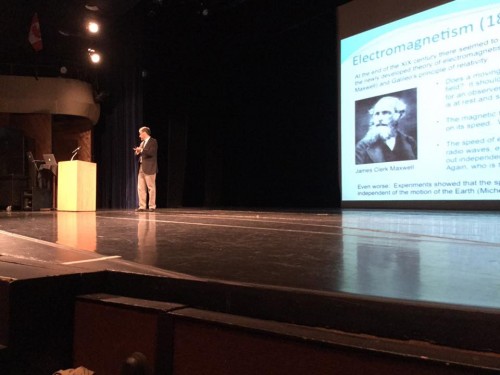
Time traveller: Miguel Alcubierre works the crowd in Edmonton.
By Hamish Johnston at the CAP Congress in Edmonton, Canada
The first day of the Canadian Association of Physicists (CAP) Congress at the University of Edmonton closed yesterday on the theme of time travel. Surely that is science fiction, you are thinking? But Miguel Alcubierre of the National Autonomous University of Mexico (UNAM) wasn’t joking when he delivered the Herzberg Memorial Lecture yesterday evening (although he did giggle a lot during his talk, which was very endearing). The session was called “Faster than the speed of light” and it was a fascinating romp through some of the more bizarre implications of Einstein’s general theory of relativity (GR) – which is 100 years old this year.
He spoke about the “Alcubierre drive”, which he first postulated in 1994 as a way of travelling faster than the speed of light within a “warp bubble” in space without violating GR. What’s the catch? You need vast amounts of negative energy, which you are not going to find at your local filling station.
There was a reception after the talk and I caught up with physicists from the University of Calgary, including Rachid Ouyed, who is founder of the Quark Nova Project. Over beer and samosas, he explained how some supernovae could occur in a two-step process. The first step is the conventional supernova explosion of a star that leaves behind a neutron star. Then, Ouyed argues, a second explosion occurs during which the neutron star is transformed into a quark star. This happens because the neutron star continues to collapse until the quarks are liberated from their neutrons, thus creating a new phase of matter and giving off a tremendous amount of energy. What is left behind is an incredibly dense “quark star”.
In his talk yesterday afternoon, Ouyed discussed observational evidence for quark novae. He also made the tantalizing suggestion that if some of the Type 1a supernovae used to measure distance in the universe are quark novae, then the evidence for the accelerating expansion of the universe is considerably weaker. Move over dark energy, here come the quark novae.
There is more on quark novae in the video below.
Really doubt that a ‘Quark Nova’ could be mistaken for a Type 1(a) supernova.
Though Gamma ray bursts might be Quark novae
As a function of their masses, the stars pass the phase of a white dwarf star stabilised by the degenrate electron pressure against the gravity, to a neutron star stabilised by the degenerate neutron pressure pressure against the gravity, to a quark star stablised by the degenerate quark pressure against the gravity and finally to the the singularity of a black hole. Further processes lead each of them to the nova stage.
I dont think quark novae “disprove” dark energy (as this article seems to suggest). If you look at their actual paper (on the arxiv) they just say that you cant trust sn ia as standard candles. There is a lot of other evidence for dark energy….
Agreed, I was being a bit cheeky with that last comment. Ouyed himself points out there is other evidence for dark energy in this video interview Rachid Ouyed talks about quark novae and the quark stars they could produce .
I HOPE THAT THERE ARE QUARK NOVAE THAT GENERATE HARD-DRIVING ROCK AND ROLL SOUNDTRACKS IN THE ABYSS OF SPACE. SYMPHONIC QUARK NOVAE SEEM AT BIT 1920’S QUANTUM CONFERENCE FEEL.. ON A LESS FLIPPANT NOTE, MY PRIMITIVE UNDERSTANDING OF SUPERNOVA MECHANICS IS THAT A FUNDAMENTAL ASYMMETRY IS REQUIRED TO GENERATE THE GIGANTIC EXPLOSION BUT EVERY TIME I SEE A SUPERNOVA VIDEO THE SIMULATION IS ALWAYS VERY SYMMETRICAL. HOW MUCH ASYMMETRY IS NECESSARY AND COULD A SIMULATION BE MADE TO REFLECT THIS OR AM I NOT ONLY WRONG BUT INCREDIBLY WRONG… ROCK ON, DEAR LITTLE QUARK NOVA !